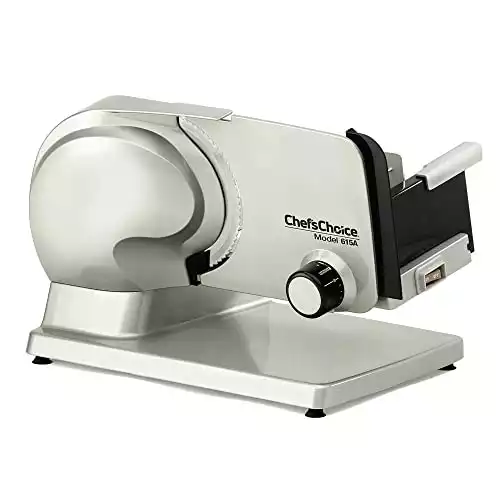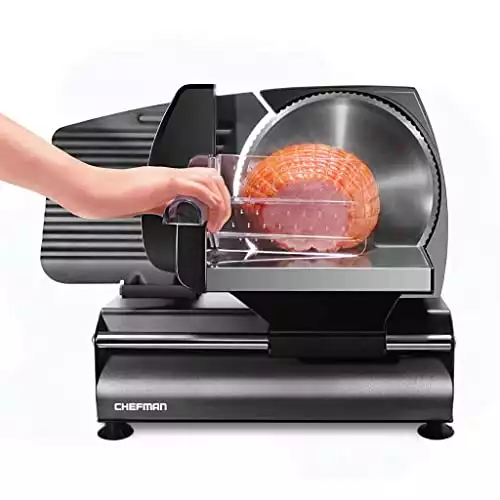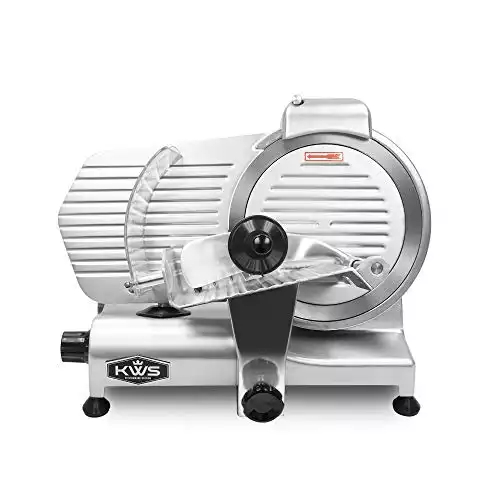What would a sandwich be without thinly sliced deli meats? Pretty disappointing, that’s what. And if you’re tired of paying a premium for thinly sliced ham, turkey, and chicken at the grocery, why not cut them yourself?
That’s exactly what a home-use meat slicer promises. I’ve had the uncique experience of using a variety of meat slicers during my time as the charcuterie prep person for a kitchen in New Orleans. Now, I’m bringing that experience to bear in these meat slicer reviews. By the time you’re finished reading, you’ll know for certain whether you need one in your own kitchen, too.c
In This Article
Best Overall: Chef’sChoice Electric Meat Slicer
Even though it’s offered at the price of a home-use model, the Chef’sChoice Electric Meat Slicer has a design that’s closer to commercial grade. The combination of value and performance makes it one of the best meat slicers for home use, bar none.
On paper, the Chef’sChoice’s 120 Watt motor may not look that impressive. But it’s small for a very good reason: It helps keep the size of this machine smaller and better for kitchen countertops. And because the motor has exceptionally high torque, it has excellent cutting power.
While most home-use meat slicers have an upright design, the Chef’sChoice goes for the more professional-grade tilted carriage. This ensures that meat falls effortlessly away from the 7-inch stainless steel blade while you’re slicing.
The entire machine is easy to disassemble and clean, too. The blade, food carriage, food pusher, and “thickness control” plate are all removable. And when you take them all off for a thorough cleaning, the unidirectional serrated blade is fully exposed for easy cleaning, too.
Wrap all of those great features up in a 1-year warranty that covers parts and labor, and you have what I consider the best overall meat slicer for at-home use.
What we like
- Price of a home model, design of a commercial one
- High torque motor for effortless cutting
- Tilted design lets slices fall away smoothly
What We don’t
- The motor could be more powerful
- Serrated blade will eventually require professional sharpening or replacement
- Customer service can be hard to get ahold of
Best Value: Chefman Die-Cast Electric Deli & Food Slicer
Buying any home meat slicer is going to eat into your kitchen budget. But what if you’re looking for a small, simple machine to make your slicing life easier? Turn towards the Chefman Deli & Food Slicer. It’s the only meat slicer under $100 that I can wholeheartedly recommend.
First of all, the Chefman is incredibly affordable given its powerful 180 Watt motor. That’s more than enough power to make smooth slices — a feature that’s only hindered by the roughly serrated blade. It’ll get the job done, for sure, but don’t expect picture-perfect edges on your sliced meat and cheese.
The compact 9” x 12” footprint for the Chefman definitely puts it in a class of its own. Whereas most meat slicers will take up twice that much space on your countertop, the Chefman can be left out indefinitely without crowding your kitchen.
Though the food carriage is equipped with a quick-release for easy cleaning, the Chefman could be easier to clean. The problem is how many little nooks and crannies there are, so expect to spend extra time on cleanup with this slicer.
Overall, the Chefman Food & Deli Slicer is easily the best slicer available at this price. And sure, that bargain price comes with a tradeoff in performance. But if you’re looking to get a meat slicer for your home at the best price possible, this is the appliance for you.
What we like
- Compact and space-saving footprint
- Powerful motor
- 1-year warranty
What We don’t
- Its upright design doesn’t always let the meat fall away on the first try
- Quite loud while it’s running
- Could be easier to clean
Best Upgrade: KitchenWare Station Commercial Electric Meat Slicer
If you’re serious about saving money on slicing your own meats and cheeses at home, investing in the KitchenWare Station Electric Meat Slicer is the way to go. It’s the closest you can get to a commercial-grade slicer without breaking the bank. And its performance far exceeds that of the other two slicers listed above.
At the heart of the KWS slicer is a 320 Watt motor, powering its extra-large 10-inch blade. Combined, these two aspects make this slicer capable of effortlessly cutting deli-thin slices, and even handling raw or frozen meats.
Better yet, that 10-inch blade has a flat edge that runs that self-sharpens every time you run the machine. Hidden whetstones in the base keep the edge razor-sharp, meaning that you’ll never have to replace the blade or have it professionally sharpened.
All that power is mounted on a sturdy and durable cast aluminum frame. And it’s easy to take apart for cleaning, too, with no hidden spots to frustrate your scrubbing efforts.
Overall, this KWS Electric Meat Slicer easily outperforms any competition at its price point. And though that price is quite high for a home use kitchen appliance, in my opinion, it’s worth the investment. Because if you’re looking to save money on sliced meats and cheeses, it’s better to play the long game with an appliance that will last for years.
What we like
- The most powerful motor of any slicer in this review
- 10-inch self-sharpening blade will always make effortless cuts
- Easy to disassemble and clean
What We don’t
- Fairly expensive
- Takes up a lot of countertop space
- Heavy and difficult to move
Buyer’s Guide: How to Choose the Best Meat Slicer
Without hands-on experience, it’s almost impossible to determine what the best meat slicer for home use is. So allow me to share a few tips from my restaurant days with you, giving you the background info you’ll need to choose the best meat slicer.
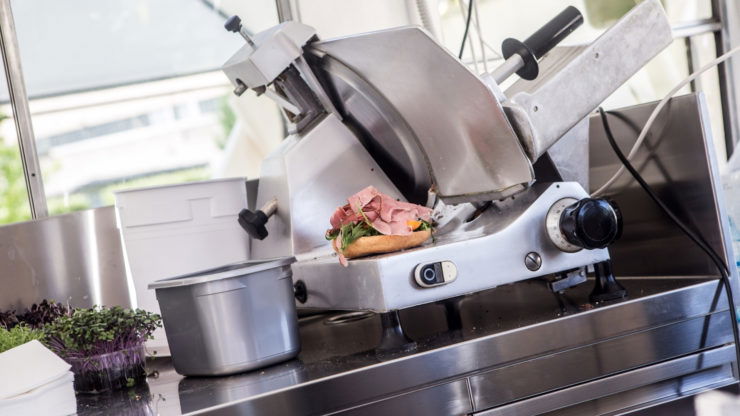
Motor
The power of a meat slicer’s motor is the very first thing you should look at when you evaluate one. That’s because motor power determines how fast the blade is going to spin, and therefore how smooth your slicing will be. Without sufficient motor power, a meat slicer will struggle to create thin, even slices.
120 Watts is a good, middle-of-the-road level of power. More than this will usually lead to faster slicing speeds, while less will require you to move more slowly while you work.
But power isn’t the only thing that makes a meat slicer’s motor work well. Depending on its gearing and design, sometimes a smaller motor may outperform a larger one in blade RPMs. So take motor power as a great starting point for comparison, but then dig deeper into how the machine works.
Blade
Even the most powerful motor won’t really matter, though, unless a meat slicer has the blade to back it up. And both the size and type of blade are where you’ll see the biggest differences between home and commercial models.
Most home models have a blade that’s around 7 inches in diameter, with a serrated edge. This combination makes them capable of slicing smaller portions of meat with great consistency. But they’ll tend to gum up with extended use, and require cleaning in the middle of a slicing job.
For the best performance during long rounds of slicing, you’ll need to look towards commercial meat slicers. Their larger blades have a flat slicing edge, perfect for working through any amount of meat without a break. That’s backed up by a more powerful motor that spins at higher RPMs, too, preventing anything from sticking to the blade.
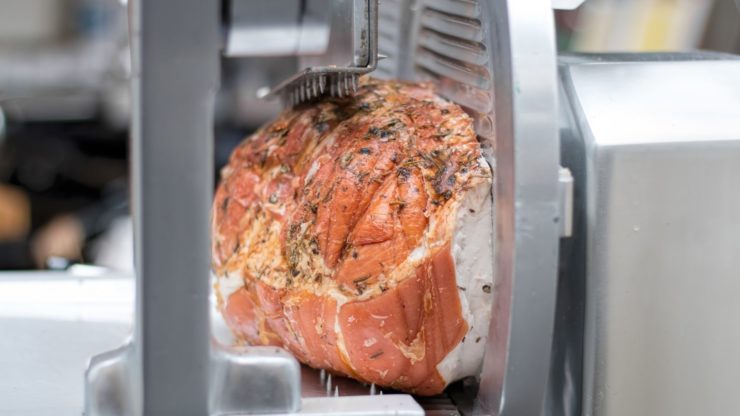
Safety
It should go without saying that any kitchen tool with a blade spinning at 100s of revolutions per minute can be dangerous. That’s why you’ll notice that all three of my recommendations have a nearly identical series of safety features.
Basically, don’t buy a meat slicer that’s lacking a way to secure your meat without having to hold it with your hands. Always go for a model that has a dedicated piece for holding your ready-to-slice goods in place while you work.
Ease of Use
Three features set the best meat slicer apart from the competition, and they’re included with all of my top recommendations. These are:
- A properly sized food carriage, complete with a pusher for safety.
- An easy way to disassemble the food carriage and slicer for cleanup (more on that in a moment).
- A way to adjust the thickness of your slices.
Combined, these three features make a meat slicer easy to use, safe, and easy to clean. If a meat slicer doesn’t offer these three things, it’s not worth your investment.
Care and Maintenance
Anyone using a meat slicer at home will need to plan for two periodic maintenance projects:
- Cleaning your meat slicer after each use.
- Having the blade sharpened about once a year.
Cleaning the meat slicer is more of a matter of hygiene. But if you don’t promptly clean this appliance every time you use it, there’s a good chance that rust will develop.
In smaller home models, you’ll eventually need to take the blade to a professional to have it sharpened. That’s because serrated blades are beyond the scope of what even a dedicated home sharpener can handle.
This is another area where a commercial-grade slicer is worth the additional investment, though. They’re often equipped with a dedicated self-sharpening system, ensuring that the blade remains at peak sharpness for every cut. About the most maintenance, you’ll need to do for a commercial meat slicer is changing the belt after three years.
Price Range
There’s a reason that you don’t see meat slicers in every home kitchen: Even the most reasonably priced ones are still a significant investment.
There’s only one meat slicer under $100 that I can wholeheartedly recommend (it’s my “best value” choice, above). After that, the best meat slicers start at about $150, and only go up from there. Commercial-grade meat slicers start at about $300, and can cost well upwards of $1000 for top-quality models.
Frequently Asked Questions About Meat Slicers
We’re closing in on the end of this guide — which means I’d like to take a moment to answer some of the most common meat slicer questions. This should help clear up any lingering doubts you have, including giving a firm verdict on whether you really need a meat slicer in your home kitchen.

Is it Worth Having A Meat Slicer?
If you’re considering buying a meat slicer for your home kitchen, ask yourself these questions:
- How often do I buy deli meat and sliced cheese from the grocery?
- How much deli meat and cheese do I buy at one time?
- How often do I (and my family) eat sliced meats and cheeses?
When you’re consistently buying multiple packs of deli meat and cheese each week, a home meat slicer might be right for you. That’s because the full-sized portions of meat and cheese can be bought much cheaper. Since there’s no cost of labor added to their slicing, you can expect to save about ⅓ of the price compared to pre-sliced meats and cheeses.
But if you’re not using your food slicer almost daily, it may not be worth the investment. And in fact, you may be better off investing in a good quality slicing knife or carving knife. With a little practice and a razor-sharp knife, you’ll be able to get deli-thin slices of those same meats and cheeses.
How Do You Use A Meat Slicer?
Meat slicers are far from being a common kitchen tool. But thankfully, their design makes them easy and intuitive to use.
You may notice that the roasted meats you can buy whole at the deli are flat on one side. That’s because they’re meant to be used with a meat slicer!
To use your meat slicer, simply load the whole loaf of meat into the food carriage on your slicer with the flat side towards the blade. Then nestle the holder into place, slide the carriage away from the blade, and turn your slicer on. Grab the handle on the carriage, apply a little pressure to the holder, and move the meat-filled carriage back and forth over the blade.
Simple as that! Just be sure to keep an eye on where the meat is falling out. You don’t want it to pile up so much that it touches the blade, as that will make for messy cuts.
Can You Cut Frozen or Raw Meat With A Slicer?
In theory, every food slicer can cut raw and/or frozen meat. But in practice, only powerful commercial-grade slicers can do so consistently.
That’s because of a combination of their more powerful motors and sharper blades. Home use models aren’t quite powerful enough to cut frozen meat, and their serrated blades will make a mess of raw meat.
Can A Meat Slicer Cut Through Bone?
A meat slicer absolutely should not be used to cut through bone. That’s a very good way to damage your very expensive kitchen appliance.
My Recommendations
At this point, what are you thinking? Would a meat slicer be a good addition to your kitchen, or are you better off investing in a high-quality slicing or carving knife?
To recap, here are the three meat slicers that I recommend:
The Chef’sChoice Electric Meat Slicer offers an excellent combination of performance and affordability. It’s the size of a home meat slicer, but the design is closer to that of a commercial one.
Anyone on a tight kitchen budget should consider the Chefman Die-Cast Electric Deli & Food Slicer. It’s the most affordable slicer for home use, and has a surprisingly powerful motor given its price.
But if you’re ready to make an investment in your kitchen equipment, the KitchenWare Station Commercial Electric Meat Slicer is the way to go. It offers commercial-grade performance and outstanding durability, complemented by a 10-inch self-sharpening blade.
Thanks for reading, and please don’t hesitate to reach out if you have any questions for us!

